Contents
Market Overview
Macro Update
This week brought a notable de-escalation in the volatile US-China economic relationship. Presidents Donald Trump and Xi Jinping met in South Korea, their first encounter since 2019, and emerged with an agreement that lowers the overall US tariff rate on Chinese goods to 47%, from 57%. In exchange, Beijing pledged to resume rare-earth exports, curb fentanyl production, and restart soybean purchases. While markets welcomed this as a constructive signal, the durability of the détente will depend on both sides’ ability to translate intent into sustained execution amid deep structural frictions.
During his broader Asia tour, President Trump also met with Japan’s new prime minister, Sanae Takaichi, and South Korea’s president, Lee Jae Myung. Both meetings signaled momentum toward renewed trade and investment ties.
On the monetary policy front, the Fed delivered a widely anticipated 25-basis-point rate cut, bringing the Fed Funds target range to 3.75–4.00%. The move was accompanied by an announcement that the program of quantitative tightening will conclude on December 1st. The decision revealed an increasingly diverse set of views within the FOMC: Governor Stephen Miran favored a 50 bps cut, while Kansas City Fed President Jeffrey Schmid argued for no cut. Chair Jerome Powell underscored that a December rate cut is “not a foregone conclusion,” tempering market expectations that had priced in further easing.
Across the Atlantic, the ECB left its policy rate unchanged at 2% for the third consecutive meeting, citing a benign inflation dynamic and ongoing economic resilience. The message from Frankfurt was clear: policy remains data-dependent. Similarly, the Bank of Japan held its target rate steady at 0.5%, though two of nine board members voted for a hike, keeping alive the possibility of policy normalization later this year.
Against this backdrop, risk assets maintained a constructive tone. Global equity indexes advanced modestly, supported by easing geopolitical risk and resilient earnings. The tech-heavy U.S. NASDAQ led gains. Yet the bond market reminded investors that monetary policy is not on a one-way easing path: U.S. Treasury yields moved roughly 10 bps higher, to 4.08% on the 10-year and 4.65% on the 30-year. The dollar strengthened to almost 100 on the DXY, a level not seen since July. Oil prices stabilized — Brent in the mid-$60s and WTI in the low $60s — while gold eased to around $4,000 per ounce, down from its recent $4,400 peak.
Available U.S. macro data included the Conference Board consumer confidence index, which was lower for a third consecutive month in October. Personal income and the Core PCE price index, the Fed’s preferred inflation measure, were not released due to the continuing U.S. government shutdown.
In Europe, preliminary October CPI surprised modestly to the upside in Germany (2.3% year-over-year vs. 2.2%) and came in line with expectations in France (1.0 year-over-year). The euro area Core CPI remained stable from September at 2.4% year-over-year, coming in above expectations of 2.3%, which likely cements the case for ECB rates remaining on hold. Meanwhile, growth in the euro area proved firmer than anticipated — with 3Q GDP at 1.3% year-over-year, anchored by France at 0.9% and Germany at 0.3%.
In European politics, exit polls from the Netherlands indicated a liberal victory for the progressive party D66 over the populist right-wing PVV, a result likely to reassure investors watching the broader European political landscape for signs of fragmentation or populist resurgence.
In China, the October manufacturing PMI missed to the downside (49 vs. 49.6), while the non-manufacturing and composite measures remained stable, marginally into expansion territory at 50.1 and 50, respectively. The weaker than expected manufacturing PMI marked the longest factory activity slump in nine years, prompting fresh calls for greater economic policy support even as Beijing appeared to reach a tactical economic truce with the U.S..
Elsewhere across emerging markets, developments this week offered a blend of stability and renewed investor optimism. The central banks of Chile and Pakistan left rates unchanged at 4.75% and 11.0%, respectively. In Argentina, President Javier Milei’s coalition exceeded expectations in midterm elections, securing a blocking minority in Congress. Markets responded positively, with bonds rallying 10%–25% across the curve. However, the peso’s behavior remained mixed, underscoring persistent structural vulnerabilities despite improving sentiment.
Corporate earnings continued to highlight the bifurcation between technology leaders and the rest of the market. Nvidia became the world’s first $5 trillion company, driven by record demand for its AI chips and $500 billion in confirmed orders. The more constructive tone from the Trump–Xi meeting added optimism about the firm’s continued access to the Chinese market.
Finally, on the humanitarian front, Hurricane Melissa brought devastating winds and flooding to parts of the Caribbean, including Jamaica and Cuba’s southern coast. With peak winds near 300 km/h, it ranks among the most powerful storms ever recorded in the Atlantic.
EM Credit Update
Emerging markets (EM) fixed income extended its recent momentum, posting another week of solid gains. EM hard-currency sovereign bonds returned 0.44%, with high-yield (+0.99%) once again outperforming investment grade (-0.10%). At the index level, spreads tightened by 14 bps, reflecting a 25 bps compression in high yield and 5 bps in investment grade.
Performance was led by higher-beta regions, particularly Latin America, where Argentina surged nearly 20% following stronger-than-expected results for President Milei’s coalition in the midterm elections. Broader regional sentiment lifted other high-beta credits such as Ecuador, Venezuela, and El Salvador. In contrast, Asia and the Middle East lagged, reflecting greater sensitivity to rate volatility.
EM corporates were broadly unchanged at the index level (+0.07%), with high yield (+0.31%) modestly outperforming investment grade (-0.09%). Spreads tightened 9 bps overall, driven by a 14 bps tightening in high yield and 7 bps in investment grade. The pattern largely mirrored the sovereign space: Latin America outperformed on the back of Argentina’s rally, while investment-grade corporates lagged amid rate volatility. Jamaican corporate bonds also underperformed due to hurricane-related disruptions and the potential impact on tourism—particularly airport-linked credits.
Local-currency debt gave back some of its recent gains (-0.16%), with Türkiye, Thailand, and Colombia outperforming, while Mexico, the Czech Republic, and Poland lagged in a context of a marginally firmer dollar.
Primary issuance remained active, with 14 new hard-currency deals broadly balanced between investment grade and high yield. Notable sovereign issuance came from Türkiye and Suriname, while Fortebank (Kazakhstan) printed an AT1 transaction. In the wake of Argentina’s market rebound, energy giant YPF also tapped the market, capitalizing on improved investor sentiment following the election results.
The Week Ahead
The OPEC+ production meeting will be in focus and the organization’s members are expected to continue signaling interest in raising output to capture market share; however, only Saudi Arabia appears in a position to do so in the near term. The Bank of England (BoE) is expected to hold interest rates at 4%, as is the Reserve Bank of Australia (RBA), at 3.6%. Other central bank rate decisions include Brazil, Poland, Sweden, Czechia, Malaysia, Mexico, and Norway. In the U.S., local elections will take place, with focus on the New York City mayoral contest, the New Jersey and Virginia governor’s races, and California’s redistricting fight. In addition, the Supreme Court begins to hear arguments on the legality of about 60% of President Trump’s tariffs.
In Europe, ECB President Christine Lagarde gives a keynote speech in Bulgaria on the eurozone. In the global macro data universe, markets will see various PMI releases from China, the euro area, France, Germany, India, and the UK. October CPI will be reported in South Korea, Indonesia, Pakistan, the Philippines, Thailand, Taiwan, Vietnam, Chile, and Mexico. Markets will also expect October ISM Manufacturing and the preliminary November University of Michigan consumer sentiment index in the U.S., German factory orders and industrial production, and euro area retail sales.
In the corporate world, embattled Chinese property developer Country Garden is expected to hold creditor meetings to vote on its offshore restructuring plan, while Tesla holds its annual meeting, during which shareholders will vote on Elon Musk’s proposed trillion-dollar pay package.
Fixed Income
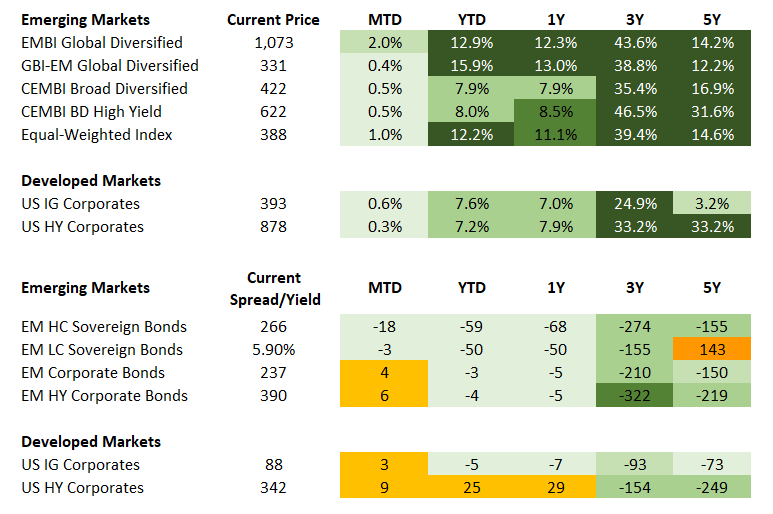
Equities

Commodities

Source for data tables: Bloomberg, JPMorgan, Gramercy. EM Fixed Income is represented by the following JPMorgan Indicies: EMBI Global, GBI-EM Global Diversified, CEMBI Broad Diversified and CEMBI Broad High Yield. DM Fixed Income is represented by the JPMorgan JULI Total Return Index and Domestic High Yield Index. Fixed Income, Equity and Commodity data is as of Oct. 31, 2025 (mid-day).
Highlights
Argentina’s Elections Pave the Way for Coalition Building
Event: Last weekend, Argentina held its long-awaited mid-term elections, in which the government secured 41% of the vote at the national level, exceeding expectations of the market, pollsters, and political analysts. The main opposition coalition obtained 32% support. President Milei’s party and allies will control 43% of the Lower House and 33% of the Senate, cementing veto power. President Milei’s speech focused on structural reforms, governor agreements, and coalition building. Argentine bonds gained 10%-25% across the global curve in the aftermath. While pressure on the peso eased relative to pre-election dynamics, forces were more mixed relative to bonds.
Gramercy Comment: We see the electoral outcome as a renewed mandate for President Milei, affording him the opportunity for constructive evolution of his political approach and to further macroeconomic adjustment. The composition of the new Congress, which takes office on December 10th,, should incentivize governors and politicians to work with Mr. Milei, opening the possibility for progress on long-discussed structural reforms. Investors will watch for progress in upcoming meetings with governors, as well as the 2026 budget process. On the economic front, an eventual adjustment to the existing foreign exchange framework will likely be needed to drive organic foreign exchange reserve gains in 2026, but improved sentiment alongside the U.S. backstop may drive authorities to adopt a more patient approach.
Ecuador’s President Appears Well-positioned Ahead of November Referendum
Event: A survey published this week by a local pollster in Ecuador found that around 60% of respondents support President Daniel Noboa’s proposal to write a new constitution, which will be one of four questions in the upcoming national referendum on November 16th. In addition, the same survey placed President Noboa’s approval rating at close to 55%, a strong level in the historical context of Ecuadorian presidents at this stage of their mandates.
Gramercy Comment: President Noboa’s relatively high approval rating heading into the referendum improves his chances of getting a positive outcome. A “Noboa-friendly” result in the referendum, especially on the important question of constitutional reform, would further reinforce the president’s political capital, a credit-positive development.
However, re-writing Ecuador’s constitution would involve elections for a Constituent Assembly in 2026, a process that naturally carries some level of political risk and uncertainty. In this context, markets will be monitoring developments closely for signs that the populist opposition. which has been in disarray since its resounding defeat in the April presidential elections, could be regaining political influence. A continuation of the sovereign bond complex’s strong market performance in 2026 is likely to hinge on President Noboa’s ability to manage those political risks amid his ambitious reform agenda.
Ultimately, a successful referendum outcome followed by a re-writing of the constitution, should further bolster the Noboa administration’s reform credentials and could open the door for Ecuador’s return to global capital markets in the second half of 2026, as penciled in by the IMF program.
Emerging Markets Technicals
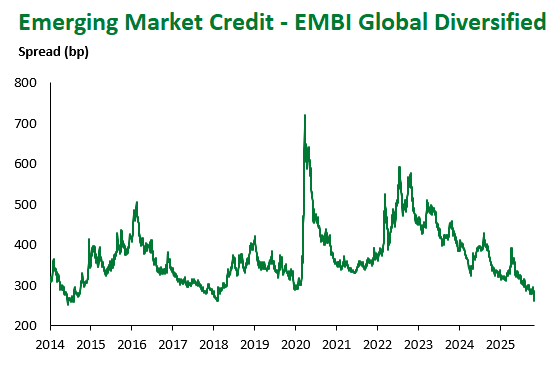
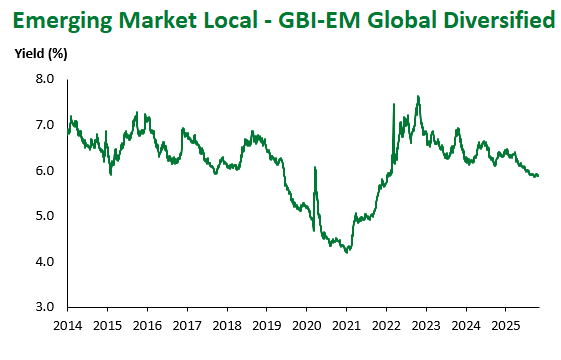
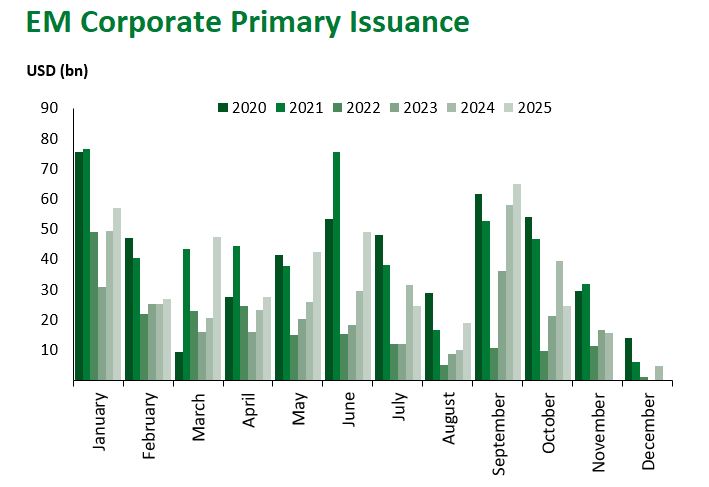

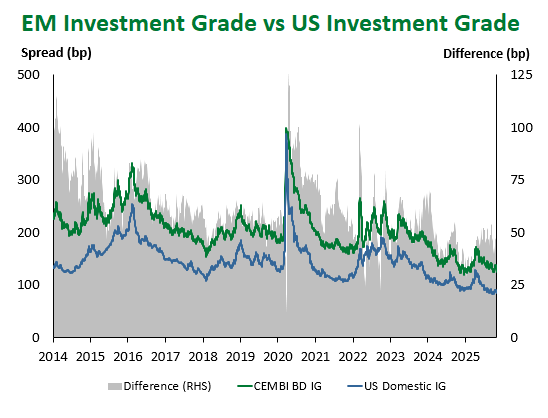

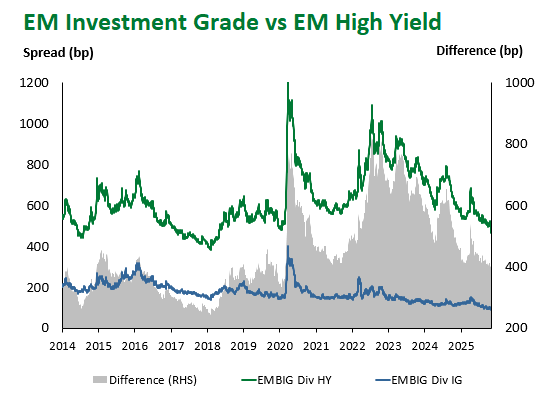

Emerging Markets Flows

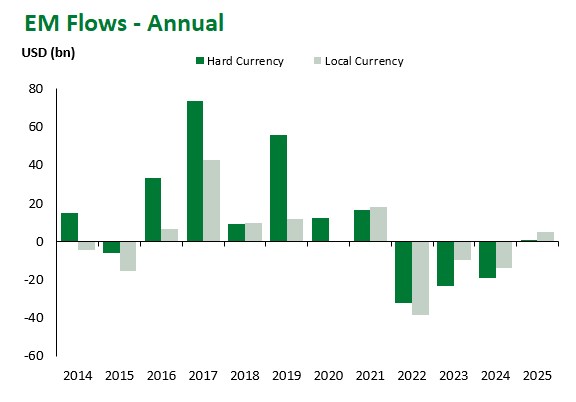
Source for graphs: Bloomberg, JPMorgan, Gramercy. As of Oct. 31, 2025.
For questions, please contact:
Kathryn Exum, CFA ESG, Director, Co-Head of Sovereign Research, [email protected]
Petar Atanasov, Director, Co-Head of Sovereign Research, [email protected]
This document is for informational purposes only. The information presented is not intended to be relied upon as a forecast, research or investment advice, and is not a recommendation, offer or solicitation to buy or sell any securities or to adopt any investment strategy. Gramercy may have current investment positions in the securities or sovereigns mentioned above. The information and opinions contained in this paper are as of the date of initial publication, derived from proprietary and nonproprietary sources deemed by Gramercy to be reliable, are not necessarily all-inclusive and are not guaranteed as to accuracy. This paper may contain “forward-looking” information that is not purely historical in nature. Such information may include, among other things, projections and forecasts. There is no guarantee that any forecasts made will come to pass. Reliance upon information in this paper is at the sole discretion of the reader. You should not rely on this presentation as the basis upon which to make an investment decision. Investment involves risk. There can be no assurance that investment objectives will be achieved. Investors must be prepared to bear the risk of a total loss of their investment. These risks are often heightened for investments in emerging/developing markets or smaller capital markets. International investing involves risks, including risks related to foreign currency, limited liquidity, less government regulation, and the possibility of substantial volatility due to adverse political, economic or other developments. References to any indices are for informational and general comparative purposes only. The performance data of various indices mentioned in this update are updated and released on a periodic basis before finalization. The performance data of various indices presented herein was current as of the date of the presentation. Please refer to data returns of the separate indices if you desire additional or updated information. Indices are unmanaged, and their performance results do not reflect the impact of fees, expenses, or taxes that may be incurred through an investment with Gramercy. Returns for indices assume dividend reinvestment. An investment cannot be made directly in an index. Accordingly, comparing results shown to those of such indices may be of limited use. The information provided herein is neither tax nor legal advice. Investors should speak to their tax professional for specific information regarding their tax situation.
